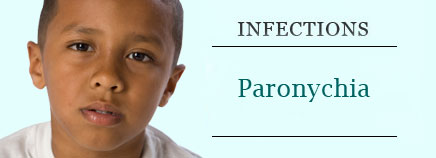
Paronychia Basics
Paronychia is an infection of the skin around a fingernail or toenail. The infected area can become swollen, red, and painful, and a pus-filled blister (abscess) may form.
Most of the time, paronychia is not serious and can be treated at home. In rare cases, the infection can spread to the rest of the finger or toe and lead to a deeper infection that may require a doctor’s help.
It’s unlikely that your child will get paronychia in a toe (unless he or she has an ingrown toenail). But fingernail paronychia is one of the most common hand infections.
Causes
Paronychia usually happens when the skin around a person’s nail is irritated or injured. When the skin is damaged like this, germs can get in and cause an infection. These germs may be bacteria (causing bacterial paronychia) or fungi (fungal paronychia).
Kids and teens can develop paronychia from:
- biting or pulling off a hangnail
- frequent sucking on a finger
- clipping a nail too short or trimming the cuticle
- getting manicures
- having hands in water a lot (as from a job washing dishes in a restaurant)
Kids with diabetes also have a higher chance of getting paronychia infections.
Symptoms
Chances are, if your child has paronychia, it will be easy to recognize. You’ll probably see an area of red, swollen skin around a nail. The area will be painful, warm, and tender to the touch, and there could be a pus-filled blister.

Bacterial paronychia usually appears very suddenly, while fungal paronychia may take longer to become apparent. Fungal paronychia may cause less obvious symptoms than bacterial paronychia, but it can be a chronic condition, meaning it can last for a long time.
Chronic paronychia can cause changes in the affected nail. It might turn a different color or look as though it is detached or abnormally shaped.
In rare cases, if the paronychia is especially severe and goes untreated, the infection can spread beyond the area of the nail.
Diagnosis
If your child has paronychia that doesn’t get better with treatment or if the infection seems to be spreading, call a doctor.
Usually, a doctor or nurse practitioner will be able to diagnose paronychia just by examining the infected area. In some cases, the doctor may take a pus sample and have it examined in a laboratory to determine what type of bacteria or fungus is causing the infection.
Treatment
Treating paronychia depends on how severe the infection is and whether it has started to spread. Often, just soaking the infected nail in warm water for 20 minutes a few times a day will help it heal on its own in a few days.
If an abscess (a pus-filled blister) forms, it may need to be drained by a doctor. In rare cases, part of the nail may have to be removed. This should never be attempted at home, as it could increase the risk of serious complications. The doctor also might prescribe antibiotic medications to treat the infection.
Usually, once an abscess is treated, the affected finger or toe heals quickly with no long-term complications.
For fungal paronychia, the doctor may prescribe antifungal creams, lotions, or oral medications to help treat the underlying cause of the condition.
Prevention
Have kids follow these tips to minimize their risk of paronychia:
- Don’t bite or pick nails.
- Trim fingernails and toenails with clippers or manicure scissors, and smooth the edges with an emery board or nail file. The best time to do this is after a bath or shower, when nails are softer.
- Don’t push cuticles back or trim them and don’t use cuticle remover. Damaging cuticles can let bacteria get into the skin and cause an infection.
- Have your child wear rubber gloves if there’s a chance his or her hands might come into contact with harsh detergents or chemicals.
- If your child has diabetes, make sure it is well controlled.
As much as possible, have kids try to avoid injuring their nails and the skin around them. Nails grow very slowly, so any damage to them can last a long time and increase the risk of paronychia.

